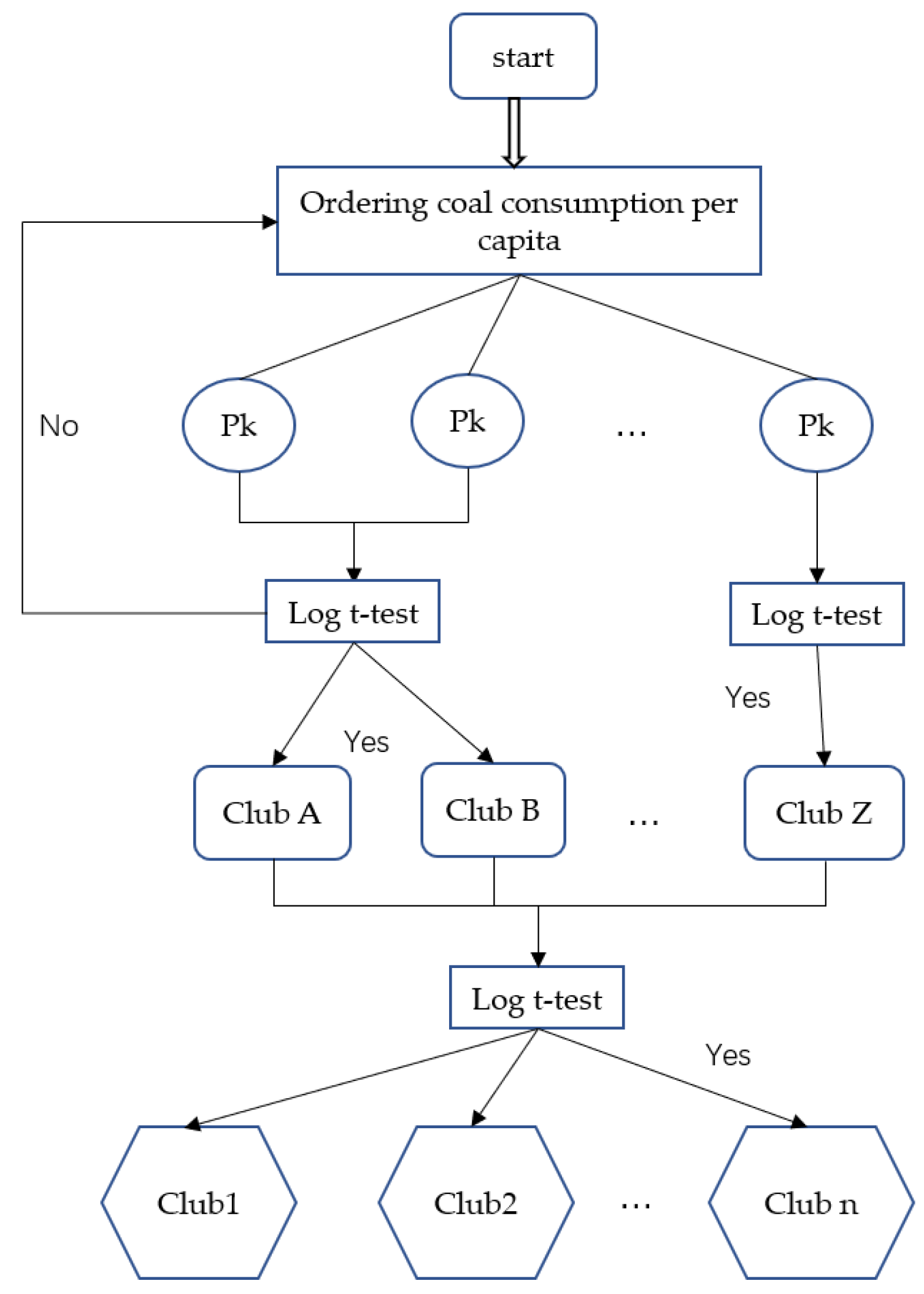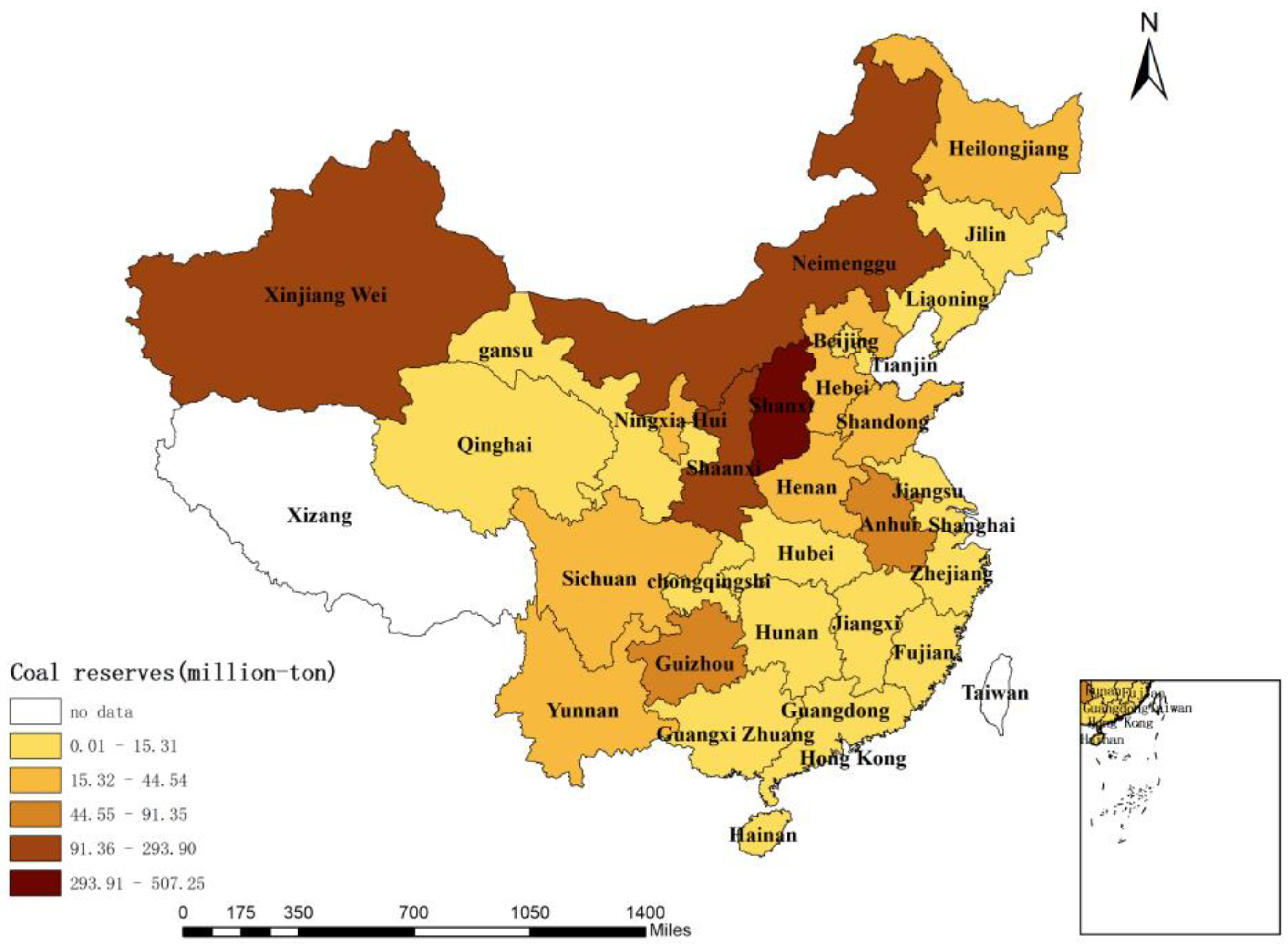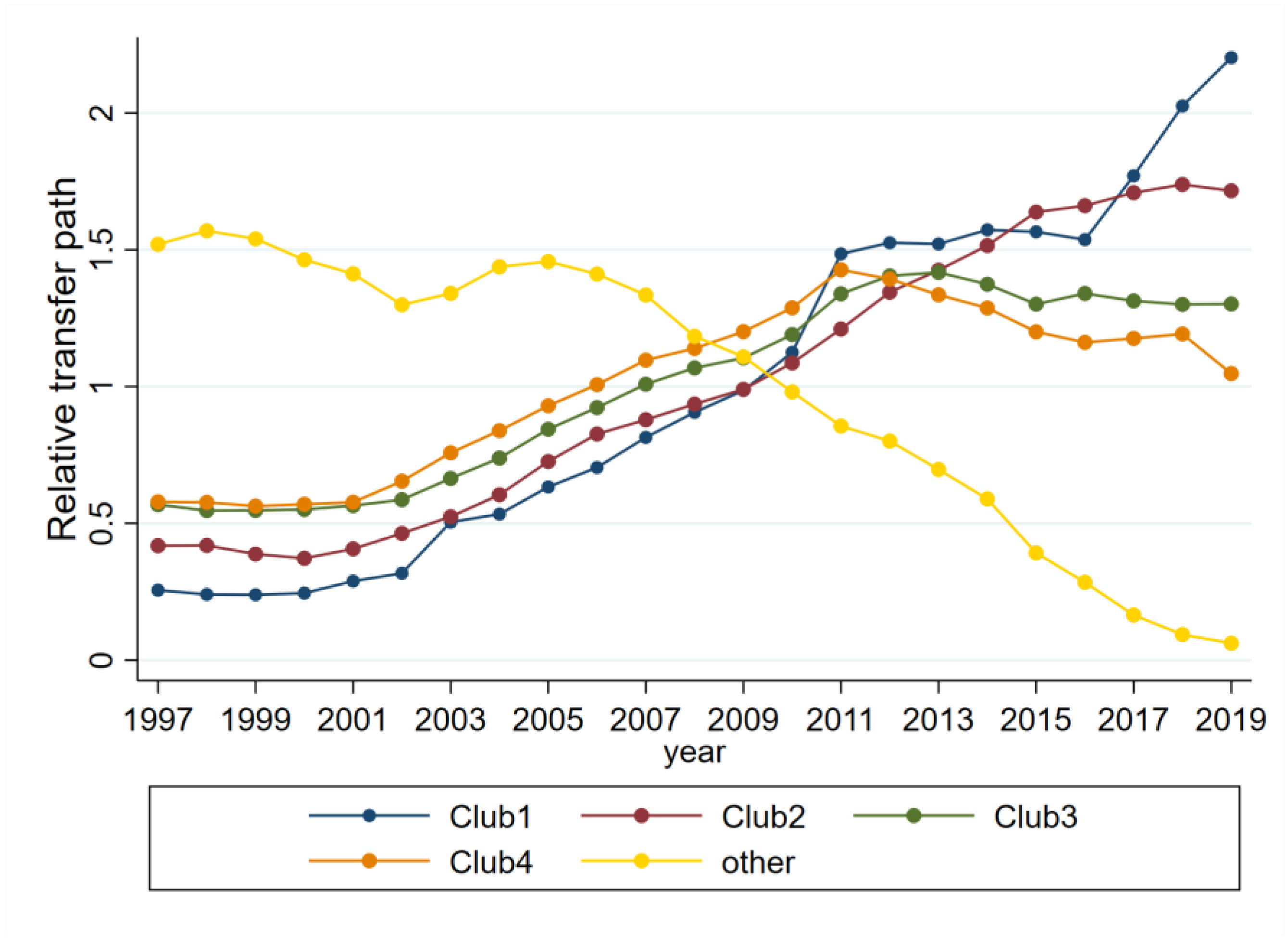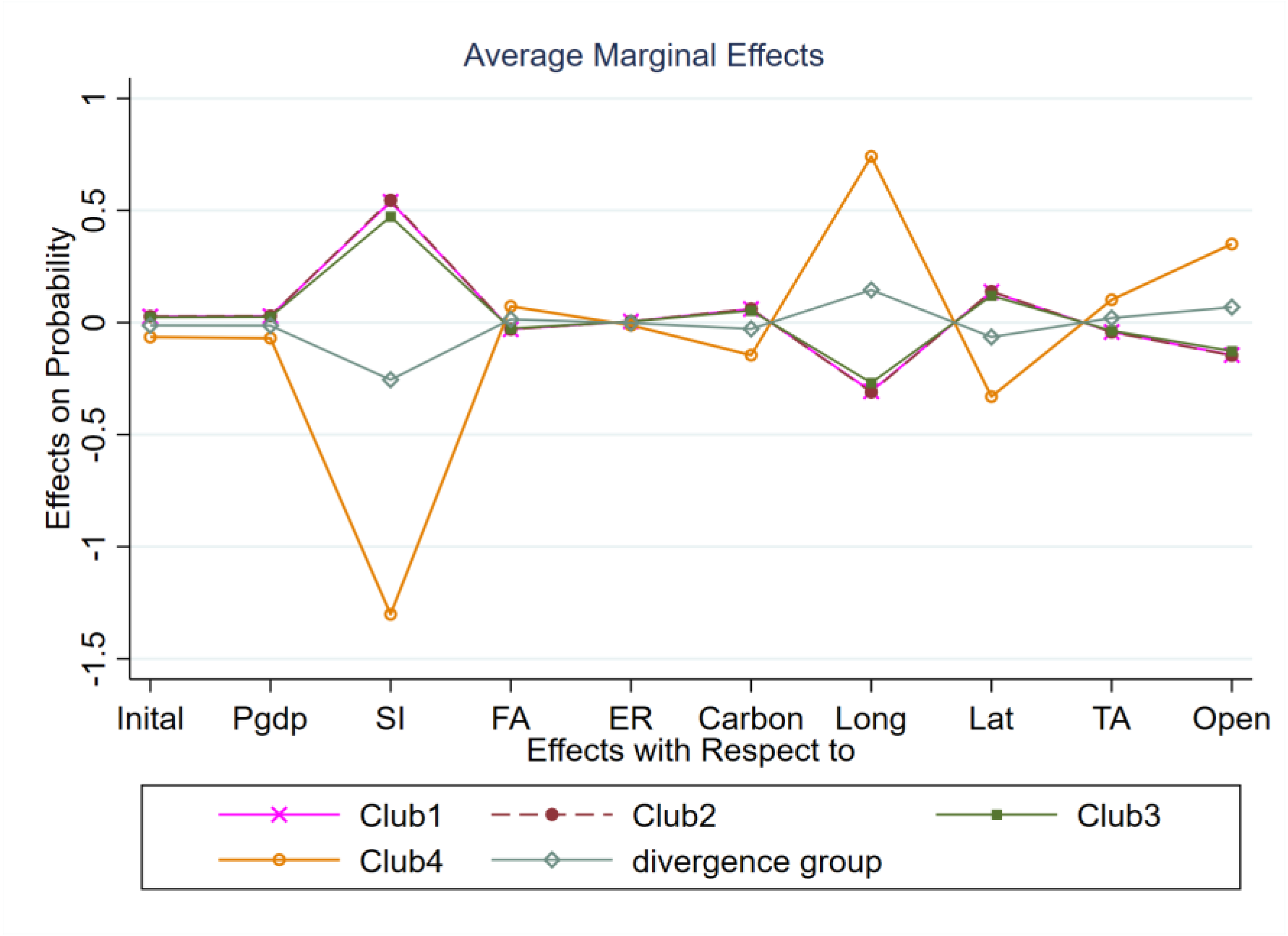On the Club Convergence in China’s Provincial Coal Consumptions: Evidence from a Nonlinear Time-Varying Factor Model
Abstract
:1. Introduction
2. Literature Review
3. Methods
3.1. Logt Test
3.2. Club Convergence Algorithm
4. Results
4.1. Data
4.2. Full Panel Convergence
4.3. Convergence Club Classification
4.4. Relative Transfer Path Analysis
4.5. Analysis of Influencing Factors of Convergence Clubs
5. Discussion
6. Conclusions and Policy Implications
Author Contributions
Funding
Institutional Review Board Statement
Informed Consent Statement
Data Availability Statement
Conflicts of Interest
Abbreviations
| Initial | Levels initial |
| Pgdp | GDP per capital |
| SI | Industrial structure |
| FA | Investment in fixed assets |
| ER | Environment regulation |
| Carbon | Carbon dioxide |
| Long | Longitude |
| Lat | Latitude |
| Open | Opening |
| TA | Technology advancement |
References
- Shi, D. Energy security and energy safety measures. Nanomaterials 1998, 12, 56–57. [Google Scholar]
- Central Documentary Research Office of the Communist Party of China. Excerpts from Xi Jinping’s Discourse on Socialist Social Construction; Central Literature Publishing House: Beijing, China, 2017. [Google Scholar]
- Adebayo, T.S.; Awosusi, A.A.; Bekun, F.V. Coal energy consumption beat renewable energy consumption in South Africa: Developing policy framework for sustainable development. Renew. Energy 2021, 175, 1012–1024. [Google Scholar] [CrossRef]
- Winzer, C. Conceptualizing energy security. Energy Policy 2012, 46, 36–48. [Google Scholar] [CrossRef] [Green Version]
- Huang, Y.; Yi, Q.; Kang, J.X.; Zhang, Y.G.; Li, W.Y.; Feng, J.; Xie, K.C. Investigation and optimization analysis on deployment of China coal chemical industry under carbon emission constraints. Appl. Energy 2019, 254, 113684. [Google Scholar] [CrossRef]
- Tang, X.; Jin, Y.; McLellan, B.C.; Wang, J.; Li, S. China’s coal consumption declining—Impermanent or permanent? Resour. Conserv. Recycl. 2018, 129, 307–313. [Google Scholar] [CrossRef]
- Liu, L.C.; Cheng, L.; Zhao, L.T.; Cao, Y.; Wang, C. Investigating the significant variation of coal consumption in China in 2002–2017. Energy 2020, 207, 118307. [Google Scholar] [CrossRef]
- Jiang, S.; Yang, C.; Guo, J.; Ding, Z. ARIMA forecasting of China’s coal consumption, price and investment by 2030. Energy Sources Part B Econ. Plan. Policy 2018, 13, 190–195. [Google Scholar] [CrossRef]
- Bloch, H.; Rafiq, S.; Salim, R. Coal consumption, CO2 emission and economic growth in China: Empirical evidence and policy responses. Energy Econ. 2012, 344, 518–528. [Google Scholar] [CrossRef]
- Tiwari, A.K.; Shahbaz, M.; Hye, Q.M.A. The environmental Kuznets curve and the role of coal consumption in India: Cointegration and causality analysis in an open economy. Renew. Sustain. Energy Rev. 2013, 18, 519–527. [Google Scholar] [CrossRef] [Green Version]
- Apergis, N.; Payne, J.E. Coal consumption and economic growth: Evidence from a panel of OECD countries. Energy Policy 2010, 38, 1353–1359. [Google Scholar] [CrossRef]
- Shahbaz, M.; Tiwari, A.K.; Nasir, M. The effects of financial development, economic growth, coal consumption and trade openness on CO2 emissions in South Africa. Energy Policy 2013, 61, 1452–1459. [Google Scholar] [CrossRef]
- Shahbaz, M.; Farhani, S.; Ozturk, I. Do coal consumption and industrial development increase environmental degradation in China and India? Environ. Sci. Pollut. Res. 2015, 22, 3895–3907. [Google Scholar] [CrossRef] [PubMed]
- Magazzino, C.; Mele, M.; Schneider, N. A machine learning approach on the relationship among solar and wind energy pro-duction, coal consumption, GDP, and CO2 emissions. Renew. Energy 2021, 167, 99–115. [Google Scholar] [CrossRef]
- Lei, Y.; Li, L.; Pan, D. Study on the relationships between coal consumption and economic growth of the six biggest coal con-sumption countries: With coal price as a third variable. Energy Procedia 2014, 61, 624–634. [Google Scholar] [CrossRef] [Green Version]
- Xie, X.; Ai, H.; Deng, Z. Impacts of the scattered coal consumption on PM2.5 pollution in China. J. Clean. Prod. 2019, 245, 118922. [Google Scholar] [CrossRef]
- Yang, X.; Zhang, J.; Ren, S.; Ran, Q. Can the new energy demonstration city policy reduce environmental pollution? Evidence from a quasi-natural experiment in China. J. Clean. Prod. 2021, 287, 125015. [Google Scholar] [CrossRef]
- Salah, W.A.; Abuhelwa, M.; Bashir, M.J.K. The key role of sustainable renewable energy technologies in facing shortage of energy supplies in Palestine: Current practice and future potential. J. Clean. Prod. 2021, 293, 125348. [Google Scholar] [CrossRef]
- Zhao, J.; Patwary, A.K.; Qayyum, A.; Alharthi, M.; Bashir, F.; Mohsin, M.; Abbas, Q. The determinants of renewable energy sources for the fueling of green and sustainable economy. Energy 2022, 238, 2029. [Google Scholar] [CrossRef]
- Xie, Y.; Wu, D.; Zhu, S. Can new energy vehicles subsidy curb the urban air pollution? Empirical evidence from pilot cities in China. Sci. Total Environ. 2021, 754, 142232. [Google Scholar] [CrossRef]
- Long, R.; Wang, H.; Chen, H. Regional differences and pattern classifications in the efficiency of coal consumption in China. J. Clean. Prod. 2016, 112, 3684–3691. [Google Scholar] [CrossRef]
- Li, R.; Leung GC, K. Coal consumption and economic growth in China. Energy Policy 2012, 40, 438–443. [Google Scholar] [CrossRef]
- Yu, J.L.; Shao, C.F.; Xue, C.Y. China’s aircraft-related CO2 emissions: Decomposition analysis, decoupling status, and future trends. Energy Policy 2020, 138, 12–15. [Google Scholar] [CrossRef]
- Phillips, P.C.B.; Sul, D. Transition modeling and econometric convergence tests. Econometrica 2007, 75, 1771–1855. [Google Scholar] [CrossRef] [Green Version]
- Solow, R.M. A contribution to the theory of economic growth. Q. J. Econ. 1956, 70, 65–94. [Google Scholar] [CrossRef]
- Barro, R.J.; Sala-I-Martin, X. Convergence. J. Political Econ. 1992, 100, 223–251. [Google Scholar] [CrossRef]
- Barro, R.J. Determinants of Economic Growth: A Cross-Country Empirical Study; The MIT Press: Cambridge, MA, USA; London, UK, 1998. [Google Scholar]
- Galor, O. Convergence? Inferences from theoretical models. Econ. J. 1996, 106, 1056–1069. [Google Scholar] [CrossRef]
- Barro, R.J.; Sala-i-Martin, X.; Blanchard, O.J.; Hall, R.E. Convergence across states and regions. Brook. Pap. Econ. Act. 1991, 1991, 107–182. [Google Scholar] [CrossRef] [Green Version]
- Baumol, W.J. Productivity Growth, Convergence, and Welfare: What the Long-run Data Show. Am. Econ. Rev. 1986, 76, 1072–1085. [Google Scholar]
- Chatterji, M. Convergence clubs and endogenous growth. Oxf. Rev. Econ. Policy 1992, 8, 57–69. [Google Scholar] [CrossRef]
- Chatterji, M.; Dewhurst, J.H.L. Convergence clubs and relative economic performance in Great Britain: 1977–1991. Reg. Stud. 1996, 30, 31–39. [Google Scholar] [CrossRef]
- Iacovone, L.; Sanchez, B.L.F.; Sharma, S. Regional Productivity Convergence in Peru; Social Science Electronic Publishing: Rochester, NY, USA, 2018. [Google Scholar]
- List, J.A. Have air pollutant emissions converged among U.S. regions? Evidence from unit root tests. South Econ. J. 1999, 66, 144–155. [Google Scholar] [CrossRef]
- FIingleton, B. Spurious spatial regression: Some monte carlo results with a spatial unit root and spatial cointegration. J. Reg. Sci. 1999, 39, 1–19. [Google Scholar] [CrossRef]
- Camarero, M.; Castillo, J.; Picazo-Tadeo, A.J.; Tamarit, C. Eco-efficiency and Convergence in OECD Countries. Environ. Resour. Econ. 2013, 55, 87–106. [Google Scholar] [CrossRef] [Green Version]
- Herrerias, M.J.; Liu, G. Electricity Intensity Across Chinese Provinces: New Evidence on Convergence and Threshold Ef-fects. Energy Econ. 2013, 36, 268–276. [Google Scholar] [CrossRef]
- Mishra, V.; Smyth, R. Convergence in energy consumption per capita among ASEAN countries. Energy Policy 2014, 73, 180–185. [Google Scholar] [CrossRef]
- Sheng, Y.; Shi, X.; Zhang, D. Economic growth, regional disparities and energy demand in China. Energy Policy 2014, 71, 31–39. [Google Scholar] [CrossRef]
- Solarin, S.A.; Gil-Alana, L.A.; Al-Mulali, U. Stochastic convergence of renewable energy consumption in OECD countries: A fractional integration approach. Environ. Sci. Pollut. Res. 2018, 25, 17289–17299. [Google Scholar] [CrossRef]
- Mulder, P.; De Groot, H.L.F. Structural change and convergence of energy intensity across OECD countries, 1970–2005. Energy Econ. 2012, 34, 1910–1921. [Google Scholar] [CrossRef] [Green Version]
- Meng, M.; Payne, J.E.; Lee, J. Convergence in per capita energy use among OECD countries. Energy Econ. 2013, 36, 536–545. [Google Scholar] [CrossRef]
- Fallahi, F.; Voia, M.C. Convergence and persistence in per capita energy use among OECD countries: Revisited using confidence intervals. Energy Econ. 2015, 52, 246–253. [Google Scholar] [CrossRef]
- Liddle, B. Revisiting world energy intensity convergence for regional differences. Appl. Energy 2010, 87, 3218–3225. [Google Scholar] [CrossRef]
- Mohammadi, H.; Ram, R. Convergence in energy consumption per capita across the U.S. states, 1970–2013: An exploration through selected parametric and non-parametric methods. Energy Econ. 2017, 62, 404–410. [Google Scholar] [CrossRef]
- He, Y. Economic Convergence in Transition Economy of China: An Empirical Study with a Nonlinear Time-varying Factor Model. Econ. Res. J. 2008, 7, 39–51. [Google Scholar]
- Spreafico, C.; Landi, D. Investigating students’ eco-misperceptions in applying eco-design methods. J. Clean. Prod. 2022, 342, 130866. [Google Scholar] [CrossRef]
- Phillips, P.C.B.; Sul, D. Economic transition and growth. J. Appl. Econom. 2009, 24, 1153–1185. [Google Scholar] [CrossRef] [Green Version]
- Phillips, P.C.B.; Sul, D. Some empirics on economic growth under heterogeneous technology. J. Macroecon. 2007, 29, 455–469. [Google Scholar] [CrossRef]
- Bartkowska, M.; Riedl, A. Regional convergence clubs in Europe: Identification and conditioning factors. Econ. Model. 2012, 29, 22–31. [Google Scholar] [CrossRef] [Green Version]
- Ghosh, M.; Ghoshray, A.; Malki, I. Regional divergence and club convergence in India. Econ. Model. 2013, 30, 733–742. [Google Scholar] [CrossRef]
- Liu, X.T.; Li, Q.; Wu, C. Dynamic Analysis of Agricultural Total Factor Productivity in China—Based on SFA Model and LOG(T) Regression Method. Chin. J. Agric. Resour. Reg. Plan. 2022, 16, e0257239. [Google Scholar]
- Wang, S.G.; Chen, Y.Q.; Tian, X. Research on the Development Status and Convergence of Digital Inclusive Finance in Chi-na—Investigation based on logt test. Lanzhou Acad. J. 2022, 6, 385–404. [Google Scholar]
- Panopoulou, E.; Pantelidis, T. Club convergence in carbon dioxide emissions. Environ. Resour. Econ. 2009, 44, 47–70. [Google Scholar] [CrossRef]
- Zhang, P.W.; Jia, G.S.; Mou, Q. Analysis of carbon productivity club convergence and conditioning factors in China’s construction industry. China Popul. Resour. Environ. 2019, 29, 40–49. [Google Scholar]
- Wang, Y.M.; Zhang, P.; Cai, C.D. An Empirical Study of the Convergence of Carbon Intensity in China. J. Xiamen Univ. 2014, 222, 120–128. [Google Scholar]
- Olson, D.; Zoubi, T. Convergence in bank performance for commercial and Islamic banks during and after the Global Financial Crisis. Q. Rev. Econ. Financ. 2017, 65, 71–87. [Google Scholar] [CrossRef]
- Solarin, S.A.; Tiwari, A.K.; Bello, M.O. A multi-country convergence analysis of ecological footprint and its components. Sustain. Cities Soc. 2019, 46, 101422. [Google Scholar] [CrossRef]
- Sun, H.; Kporsu, A.K.; Taghizadeh-Hesary, F. Estimating environmental efficiency and convergence: 1980 to 2016. Energy 2020, 208, 118224. [Google Scholar] [CrossRef]
- Von Lyncker, K.; Thoennessen, R. Regional club convergence in the EU: Evidence from a panel data analysis. Empir. Econ. 2017, 52, 525–553. [Google Scholar] [CrossRef]
- Li, F.; Li, G.; Qin, W.; Ma, H. Identifying economic growth convergence clubs and their influencing factors in China. Sustainability 2018, 10, 2588. [Google Scholar] [CrossRef]
- Shengren, P. Analysis of Convergence of Provincial Environmental Efficiency of China and Dynamic Processes. Manag. Rev. 2020, 32, 52–62. [Google Scholar]
- He, X.M.; Lai, Y.J. Environment Efficiency Club Convergence Analysis Based on the Nonlinear Time-Varying Factor Model. Soft Sci. 2017, 31, 103–106. [Google Scholar]
- Liu, Q.Q.; Song, R.; Zhou, G.M. Club convergence in China’s foreign tourist source market: Recognition method and convergence factors. Tour. Trib. 2021, 36, 88–102. [Google Scholar]
- Available online: https://data.stats.gov.cn/ (accessed on 19 September 2022).
- Available online: https://www.gtarsc.com/ (accessed on 19 September 2022).





| Variable | Coeff | SE | T-Stat |
|---|---|---|---|
| Log(t) | −1.7635 | 0.0346 | −50.9917 |
| Initial Club | Coeff | Test of Club Merging | Final Club | |||
|---|---|---|---|---|---|---|
| Club1 {2} | 5.045 (4.050) | Club1+2 −0.709 (−42.259) | Club1 [2] | |||
| Club2 {4} | 0.325 (16.040) | Club2+3 −0.796 (−17.791) | Club2 [4] | |||
| Club3 {9} | 0.215 (4.860) | Club3+4 −0.628 (−14.303) | Club3 [9] | |||
| Club4 {14} | 0.540 (20.708) | Club4+ divergence group −0.268 (−3.794) | Club4 [14] | |||
| divergence group | --- | |||||
| Variable | Variable Abbreviations | Unit | Description | Data Sources |
|---|---|---|---|---|
| Initial Levels | Initial | Ton | Per capita coal consumption by province in 1997 | China Statistical Yearbook [65], China Energy Statistics Yearbook [66] |
| GDP-Per capital | Pgdp | Million CNY | GDP-Per capital | |
| Industrial Structure | SI | % | The ratio of industrial output to GDP | |
| Investment in fixed assets | FA | Billion CNY | Fixed asset input costs | |
| Environment regulation | ER | Thousand CNY | Cost of industrial pollution control per thousand dollars of industrial value added | |
| carbon dioxide | Carbon | Million tons | Carbon dioxide emissions | |
| Longitude | Long | Degree | Longitude of the province | |
| Latitude | Lat | Degree | Latitude of the province | |
| Opening | Open | % | The ratio of total export-import volume to GDP | |
| technology advancement | TA | % | The ratio of R&D to GDP |
| Variable | Club1 | Club2 | Club3 | Club4 | Divergence Group | |
|---|---|---|---|---|---|---|
| Initial | −0.3704 ** (0.1527) | 0.0269 ** (0.0106) | 0.0272 ** (0.0119) | 0.0236 ** (0.0106) | −0.0650 ** (0.0272) | −0.0128 ** (0.0056) |
| Pgdp | −0.3980 *** (0.1133) | 0.0289 *** (0.0084) | 0.0293 *** (0.0085) | 0.0254 *** (0.0084) | −0.0699 *** (0.0205) | −0.0137 *** (0.0042) |
| SI | −7.4134 *** (0.9235) | 0.5391 *** (0.0796) | 0.5454 *** (0.0854) | 0.4725 *** (0.0719) | −1.3015 *** (0.1688) | −0.2554 *** (0.0385) |
| FA | 0.4111 *** (0.0901) | −0.0299 *** (0.0069) | −0.0302 *** (0.0069) | −0.0262 *** (0.0067) | 0.0722 *** (0.0160) | 0.0142 *** (0.0035) |
| ER | −0.0697 *** (0.1195) | 0.0050 *** (0.0010) | 0.0051 *** (0.0010) | 0.0044 *** (0.0009) | −0.0122 *** (0.0021) | −0.0024 *** (0.0005) |
| Carbon | −0.8293 *** (0.1129) | 0.0603 *** (0.0095) | 0.0610 *** (0.0094) | 0.0528 *** (0.0091) | −0.1456 *** (0.0197) | −0.0286 *** (0.0051) |
| Long | 4.2183 *** (0.7707) | −0.3068 *** (0.0573) | −0.3103 *** (0.0604) | −0.2688 *** (0.0622) | 0.7406 *** (0.1352) | 0.1453 *** (0.0328) |
| Lat | −1.8819 *** (0.4197) | 0.1369 *** (0.0357) | 0.1385 *** (0.0291) | 0.1199 *** (0.0236) | −0.3304 *** (0.0651) | −0.0648 *** (0.0183) |
| Open | 0.5776 *** (0.1145) | −0.0420 *** (0.0091) | −0.0425 *** (0.0087) | −0.0368 *** (0.0088) | 0.1014 *** (0.0206) | 0.0199 *** (0.0045) |
| TA | 1.9949 *** (0.2623) | −0.1451 *** (0.0220) | −0.1468 *** (0.0247) | −0.1271 *** (0.0174) | 0.3502 *** (0.0437) | 0.0687 *** (0.0123) |
Disclaimer/Publisher’s Note: The statements, opinions and data contained in all publications are solely those of the individual author(s) and contributor(s) and not of MDPI and/or the editor(s). MDPI and/or the editor(s) disclaim responsibility for any injury to people or property resulting from any ideas, methods, instructions or products referred to in the content. |
© 2023 by the authors. Licensee MDPI, Basel, Switzerland. This article is an open access article distributed under the terms and conditions of the Creative Commons Attribution (CC BY) license (https://creativecommons.org/licenses/by/4.0/).
Share and Cite
He, Y.; Qin, R.; Wang, B. On the Club Convergence in China’s Provincial Coal Consumptions: Evidence from a Nonlinear Time-Varying Factor Model. Sustainability 2023, 15, 1881. https://doi.org/10.3390/su15031881
He Y, Qin R, Wang B. On the Club Convergence in China’s Provincial Coal Consumptions: Evidence from a Nonlinear Time-Varying Factor Model. Sustainability. 2023; 15(3):1881. https://doi.org/10.3390/su15031881
Chicago/Turabian StyleHe, Yinnan, Ruxiang Qin, and Bangjun Wang. 2023. "On the Club Convergence in China’s Provincial Coal Consumptions: Evidence from a Nonlinear Time-Varying Factor Model" Sustainability 15, no. 3: 1881. https://doi.org/10.3390/su15031881





